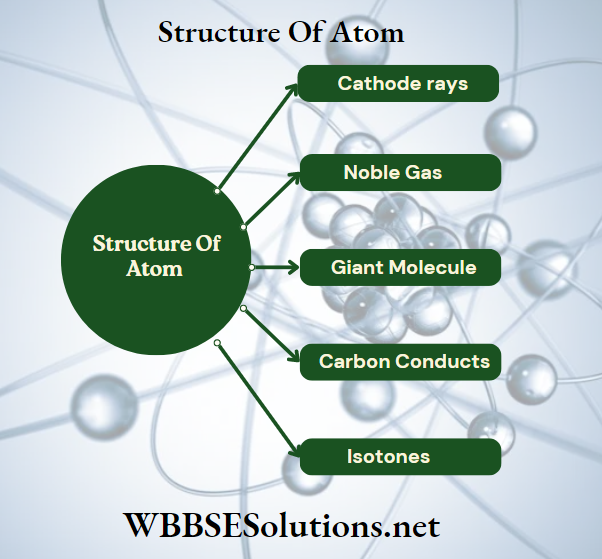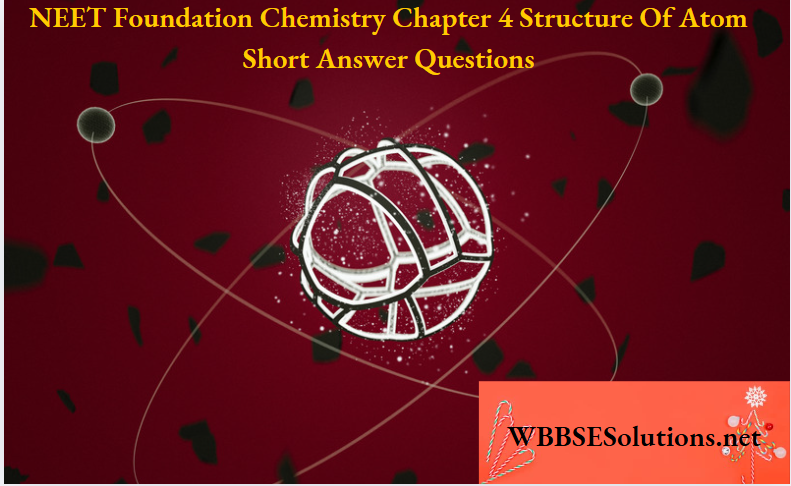Chapter 4 Structure Of Atom Short Answer Type Questions
Question 1. What are cathode rays? How are they formed?
Answer.
Cathode rays:
Cathode rays are a stream of negatively charged particles. These particles called electrons are shot from the metal cathode of a discharge tube when an electric current is passed through a gas at a very low pressure. A discharge tube is a long glass tube having two metal electrodes.
Formation Of Cathode rays:
When the pressure of air in the discharge tube is reduced to 0.001 mm of mercury and a high voltage is applied to the electrode, the emission of light by air stops. But it is noticed that the wall of the discharge tube at the end opposite the cathode begins to glow with a greenish light. Since these rays are formed at the cathode they are known as cathode rays.

Read And Learn More NEET Foundation Short Answer Questions
Question 2. What is the relation between an Ion and a Noble Gas?
Answer.
Relation between an Ion and a Noble Gas:
The electron structures of ions and noble gases are the same. The noble gases are in group 0 of the periodic table. They will not react with other atoms because they have a full outer shell of electrons and no overall charge.
Atoms which have lost or gained electrons to form ions will also have a full outer shell of electrons but because they have a charge they will form ionic bonds with other oppositely charged ions.
Ions and noble gases both have a full outer shell of electrons and therefore can have the same electron structure. A Li1+ ion has the same electron structure as Helium. A Mg2+ ion has the same electron structure as a Na1+ ion and a O21- ion.

Question 3. What is a Giant Molecule?
Answer.
Giant Molecule:
A covalently bonded substance containing a huge number of atoms is called a giant molecule or a giant covalent lattice. There are four examples of molecules (made from non-metals) which form giant structures.
They are silicon, silicon dioxide and two forms of the element carbon called diamond and graphite (polymers are a different kind of large molecule). When two (or more) forms of an element exist in the same physical state, they are called allotropes.
Diamond and graphite are allotropes of carbon. Carbon can exist as fullerenes as well as diamond and graphite.
Question 4. Why graphite-a form of carbon conducts electricity?
Answer.
Graphite-a form of carbon conducts electricity:
Carbon as a reactant or electrode, then carbon is graphite not diamond. It is written C(gr) but is usually written as just C. The structure of graphite consists of many flat layers of hexagons.
The layers are called graphene sheets. Each carbon atom in the layer is joined by strong covalent bonds to only three other carbon atoms. Carbon is in group 4 of the periodic table and so it has four electrons in its outer shell.
Three of these electrons are used for covalent bonding in the graphite sheet. There are no covalent bonds between the layers and so the layers can easily slide over each other making graphite soft and slippery and an excellent lubricant. The fourth electron between the layers is delocalised, it’s a free electron present between the layers and allows graphite to conduct electricity and heat.
| Class 11 Physics | Class 12 Maths | Class 11 Chemistry |
| NEET Foundation | Class 12 Physics | NEET Physics |
Question 5. Define isotones.
Answer.
Isotones:
Isotones are the atoms that have the same neutron number but different number of proton. For example, 5616S, 3717Cl, 3818Ar, 3919K and 4020Ca are all isotones of 20 since they all contain 20 neutrons.
Question 6. What are radioactive isotopes?
Answer.
Radioactive isotopes:
Radioactive Isotope has an unstable combination of protons and neutrons, and that is why they have an unstable nucleus. Because these are unstable, hence they undergo decay and emit alpha, beta and gamma rays. Radioactive isotopes can be useful in different industries, such as food, agriculture, archaeology and medicine.
Question 7. How does Isotopes arise?
Answer.
Isotopes Arise:
Isotopes have same atomic number but different mass number and occur due to the presence of different number of neutrons in elements which have a same atomic number as mass number is the sum of the number of neutrons and protons.
